 |
 |
 |
| |
LOW BONE MASS IN BEHAVIORALLY HIV-INFECTED YOUNG MEN ON ANTIRETROVIRAL THERAPY: Adolescent Trials Network (ATN) Protocol 021B
|
| |
| |
Reported by Jules Levin
CROI Feb 27-March 2 2011 Boston
Kathleen Mulligan1, D. Robert Harris2, Patricia Emmanuel3, Roger Fielding4, Dana S. Hardin5, Carol Worrell6, Bill G. Kapogiannis6, Dina Monte2, John Sleasman7, Grace M. Aldrovandi8, and the ATN021B study team
1University of California, San Francisco, CA; 2Westat, Rockville, MD; 3University of South Florida, Tampa, FL; 4 Jean Meyer USDA HNRC at Tufts University, Boston, MA; 5The Ohio State University, Columbus, OH;
6National Institute of Child Health and Human Development, NIH, Bethesda, MD; 7University of South Florida, St. Petersburg, FL; 8Childrens Hospital of Los Angeles, Los Angeles, CA
from Jules: these data may suggest young men who get HIV-infected and go on HAART are at greater risk for greater bone loss because they may be predisposed to developing bone loss. Although the study did not find an association between illegal drug use & bone loss other studies have suggested heroin use associated with bone loss; studies have found excessive alcohol use associated with bone loss; smoking cigarettes is associated with bone loss & lifestyle associated with using drugs like not eating properly etc. Also being skinny (low BMI), and not having yet reached peak bone mass due to their young age likely contribute to risk for bone loss
Summary/Discussion
HIV-positive young men on antiretroviral therapy with a relatively short period since HIV+ diagnosis have evidence of lower bone mass, when compared to seronegative controls of similar age and racial/ethnic distribution.
This effect appears to be more pronounced in the group on protease inhibitor-based ART. Use of PIs has been associated with increased risk of bone loss in other studies (5,7).
There were no differences among groups in BMD in the spine. However, Z-scores for the spine were below 0 in all groups, including HIV-negative controls, suggesting the presence of low bone mass among the entire population. Evidence of lower-than-expected bone mass has been reported in men with primary HIV infection (8) and healthy seronegative men at risk for acquiring HIV (9), suggesting that in some cases low bone mass may predate acquisition of HIV.
Post hoc analysis showed that use of tenofovir does not account for low bone mass in this study (data not shown).
Likewise, use of amphetamines, cocaine, marijuana, or alcohol was not associated with low bone mass (data not shown).
The clinical significance of the observed differences in bone mass and their potential impact on peak bone mass and subsequent fracture risk are not known but warrant further study and monitoring.
INTRODUCTION
Low bone mineral density (BMD) is frequently observed in HIV-infected adults, and has been associated with HIV infection, initiation and use of antiretroviral therapy, and conventional lifestyle factors (1). Some studies suggest that the risk in men may be similar to or greater than that in women (2,3)
Low BMD has also been reported in perinatally infected children (4,5).
Peak bone mass is achieved during adolescence/early adulthood and is the key determinant of bone mass later in life. (from Jules: these HIV-positives may not yet have reached peak bone mass which can occur from 20-30 yrs of age, so this may have contributed to bone loss on HAART, but also the HIV-positives had lower BMI & less ft than the HIV-neg s which probably contributed as well to bone loss)
The current study was designed to determine the association of BMD with HIV infection and antiretroviral therapy (ART) in behaviorally infected young men.
ABSTRACT
Background: Peak bone mass is achieved in adolescence or early adulthood and is the key determinant of bone mass in later life. We evaluated the association of bone mineral density with HIV infection and ART during this critical period among young men who acquired HIV via risk behaviors.
Methods: HIV+ youth (n = 199) and seronegative controls (HIV-, n = 53) aged 14 to 25 years were studied at 15 Adolescent Trials Network (ATN) sites in the US and Puerto Rico. The HIV+ participants were recruited on the basis of ART status as follows: ART-naive (n = 105) or on an ART regimen containing an NNRTI (n = 52) or PI (n = 42). Bone mineral density and body composition were measured by DXA with central analysis. Total-body Z-scores for bone mineral density were calculated using norms developed by Baylor University for youth age ≤22. Machine-generated Z-scores for total hip (age ≥20) and spine (L1-L4) were recorded. Bone results (mean±SE) were compared across groups by linear modeling, adjusting for race, body mass index, and type of DXA (Hologic/Lunar).
Results: The HIV+ and HIV- groups were comparable with regard to median age (21 years) and racial/ethnic distribution. Median times since HIV diagnosis were 1.3, 1.9, and 2.2 years in the ART-naive, NNRTI, and PI groups, respectively (p = 0.13). All ART regimens included ≥1 NRTI; 70% included tenofovir; 90% of PI regimens were ritonavir-boosted. Body mass index was lower in the HIV+ group as a whole (23.3±0.3 vs 26.0±0.9 kg/m2 in HIV-; p = 0.006). Total and regional fat were higher in HIV- and lower in the ART-naive group. Lean body mass tended to be lower in all HIV+ groups. Mean bone mineral density and Z-scores were consistently lower among HIV+ participants on ART, particularly in the PI group, than HIV-. Post-hoc analysis revealed that the low bone mineral density in those on ART could not be wholly attributed to tenofovir use.
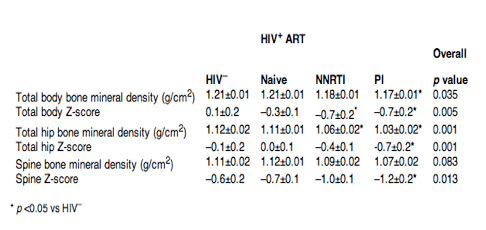
Conclusions: HIV+ young men on ART with a relatively recent diagnosis of HIV infection have lower bone mass than seronegative controls of similar age and racial/ethnic distribution. Impaired accrual of bone or actual bone loss during adolescence may confer additional risk of bone complications in later life.
METHODS
Participants:
Cross-sectional study in HIV-infected youth and seronegative controls, ages 14-25, enrolled at 15 Adolescent Trials Network (ATN) sites in the United States and Puerto Rico.
Inclusion criteria: HIV-infected participants acquired HIV through risk behavior and recruited based on current ART status as outlined below; Tanner 4 or 5; accessible medical and medications histories.
Participants were recruited into the following groups:
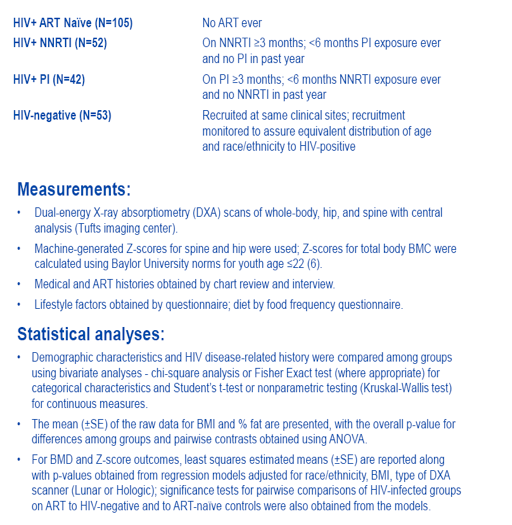
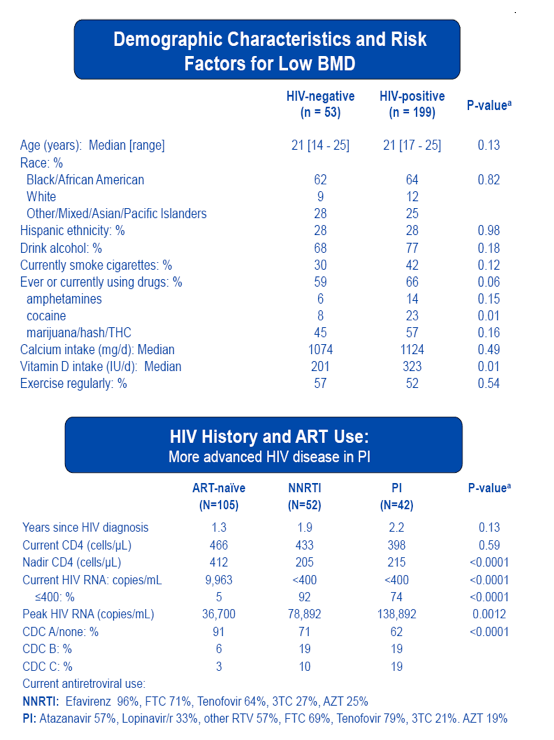
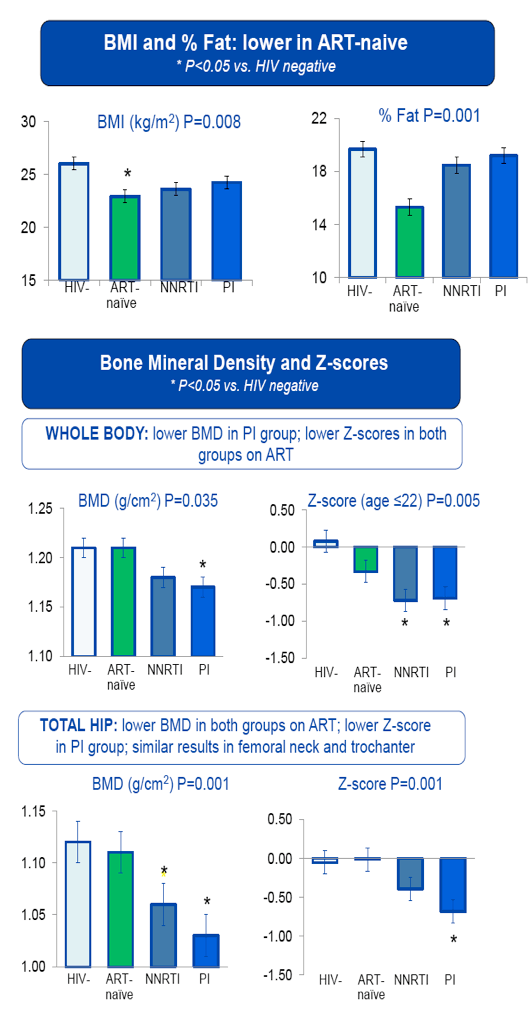
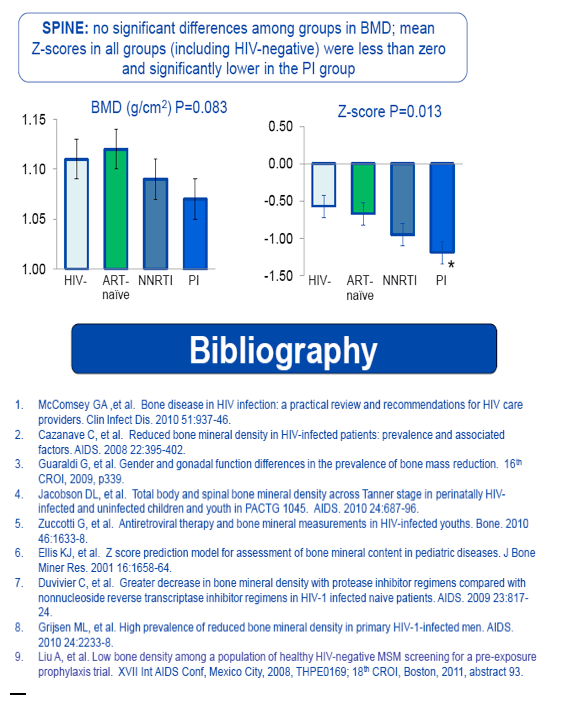
|
| |
|
 |
 |
|
|